If you’ve been here on my travel blog for a while, you know how much I love the Dolomites. I’ve visited it about 7 times in the winter before I came here to hike one summer. I spent 2 weeks hiking alone across the mountains, healing my soul and reflecting on my life and where I am supposed to go next… and well, I fell in love with the Dolomites so much so that I’ve moved here.
So, I’m writing this article for you from my apartment in the Dolomites. I’ve been exploring different places in the winter and summer for the past years. And I want to share my insider tips for visiting the Dolomites in winter with you. Enjoy!
Dolomites In Winter For Non-Skiers: Best Things To Do
Here are all the activities and things you can do in the Dolomites in winter. Have fun planning:
1. Enjoy winter hiking
2. Explore The Mountains On Cable Cars
3. Visit The Highest Mountain In The Dolomites
4. Follow The Trenches From WWI.
5. Go Cross-Country Skiing
6. Visit The Rifugios
7. Indulge In A Local Cuisine
8. Make A Road Trip Through The Mountain Passes
9. Relax In A Wellness Hotel
Travel Itinerary Planning &
1-On-1 Call With Me
| ✈ Did you know? I design customized travel itineraries. |
|---|
| ➡ Whether you’re traveling somewhere for the first time and don’t know where to start and how to plan your trip… ➡ Or you don’t want to spend a thousand hours planning your perfect trip… 👉 LET ME HELP YOU – I’ll design a travel itinerary based on your needs and interests (fill out the form below 👇). |
Or book a call with me to chat in real time, ask me any questions, and get personalised travel advice for your trip.
👉 Click here to book a call.
1. Enjoy Winter Hiking
The Dolomites are wonderful for winter walks/hikes. Just imagine walking through a snowy winter wonderland, with epic mountain peaks surrounding you. And then, you arrive at a mountain hut awaiting you with a warm strudel and delicious food.
Here are my favorite winter hikes in the Dolomites you can do in winter:
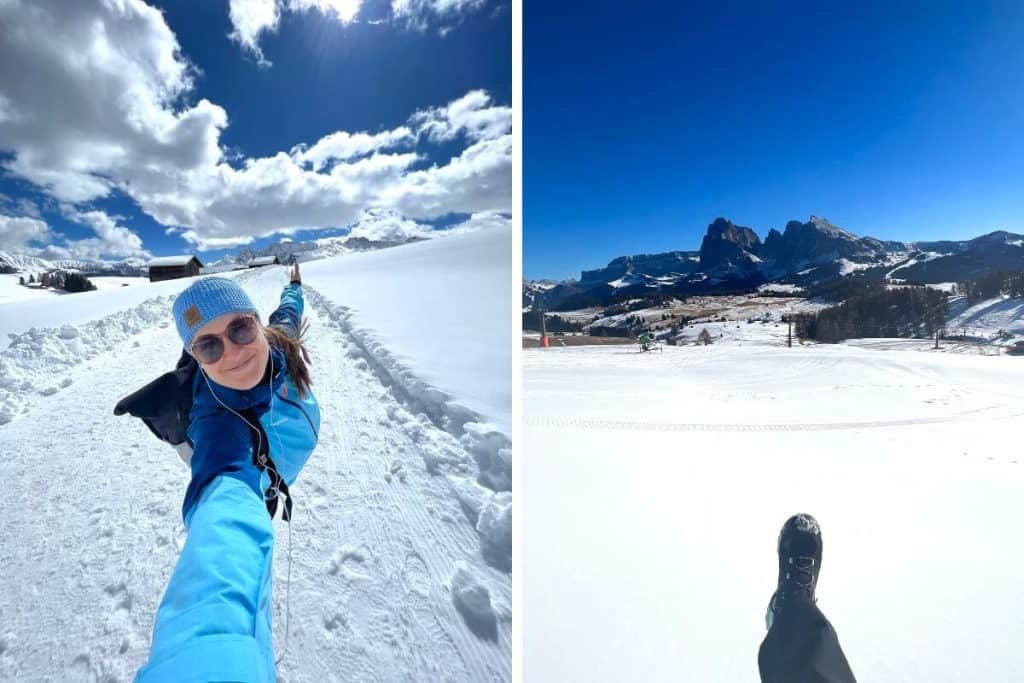
👉 Alpe di Siusi (easy walks)
Take a cable car up and walk from Compatsch via Malga Sagnon (have lunch here) to Saltria and back. Or make it up to Mont Seuc and enjoy the views of Alpe di Siusi.
👉 Lago di Braies (easy walk)
Drive to the iconic lake, and you can make a loop around the lake. It’s an easy walk, perfect for a relaxing morning/afternoon, and takes about 1.5 hours.
👉 Seceda Ridge (easy walk)
Take the cable car from Ortisei to Seceda and walk around with some of the most spectacular views in the Dolomites. Follow the hiking trails and visit some of the local huts (like Baita Sofia).
👉 Tre Cime di Lavaredo (moderate hike)
Drive to Rifugio Auronzo from Cortina d’Ampezzo and start this epic loop around the 3 iconic Dolomites’ peaks. You can go snowshoeing if there is too much snow. Check the trail conditions before you go.
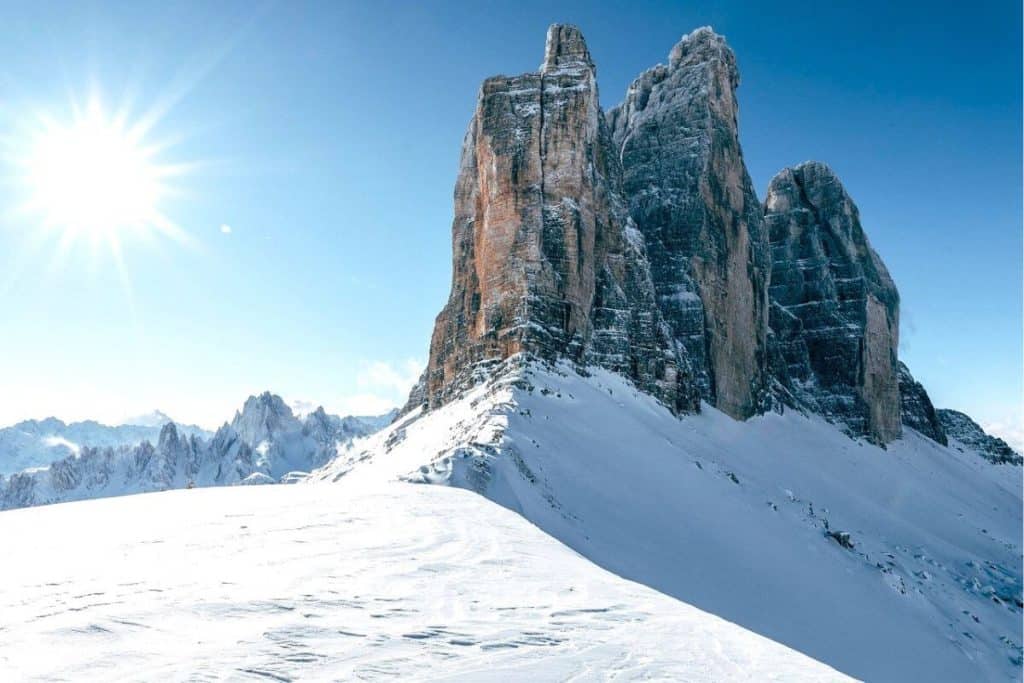
👉 Cinque Torri (easy walk)
Another beautiful hike combined with some history – take a chairlift to Cinque Torri (Rifugio Scoiattoli) and follow the trenches, tunnels, and shelters from World War I. You can also visit the Open-Air WWI Museum nearby to dive deeper into the history.
👉 Santa Maddalena (easy walk)
You can visit a cute local town called Santa Maddalena and walk around it, following a classic trail that leads towards the church. You’ll get the stunning views of dramatic peaks in the background with St. John Church. It’s like a fairy tale here. You can easily do this as a family, even with a stroller.
👉 Winter Hikes To The Rifugios
For a more serious winter hike, head to Rifugio Pederu. From there, you can hike to a remote mountain hut (Rifugio Fanes & Rifugio Lavarella). Both of them are open in the winter, and you can even stay overnight. Rifugio Lavarella has its own brewery, too.
2. Explore The Mountains On Cable Cars
I’m all about the spectacular mountains and views – and I’ve been to the highlights of the Dolomites. Standing on the top of them makes me tear up and so happy. And I want you to experience the beauty, even if you’re not skiing.
You can take a cable car to the most breathtaking mountains in the Dolomites, even in the winter. Make a mountain excursion from your hotel, enjoy food and drinks at the mountain hut at the top, and then make it down.
Here are the mountains I suggest visiting in the Dolomites in winter:
📍 Sass Pordoi
📍 Seceda
📍 Rifugio Lagazuoi
📍 Cinque Torri
📍 Kronplatz – Plan De Corones

3. Visit The Highest Mountain In The Dolomites
Talking about mountain excursions, you can’t miss the highest. I’ve saved it as a separate point because it’s going to take you a while to get there, and it’s absolutely worth it.
Take the cable cars to Marmolada – the highest mountain in the Dolomites. The cable car station is called Punta Rocca. And you’ll enjoy panoramic views of the entire Dolomites. It’s in the middle, so you’ll be surrounded by snowy peaks.
After, watch skiers/snowboarders conquering the steepest and longest slope in the Italian Alps – Flagship run‘, La Bellunese. It’s 12km long (my favorite slope in the Dolomites).
NOTE: There are no restaurants and bathrooms on the top of Punta Rocca. So make sure to use the bathroom at the middle station (Serauta). There is also a snack shop at Serauta.


👉 READ ALSO: Best Ski Resorts In Europe & My Experience
4. Follow The Trenches From WWI.
As I mentioned above, the Dolomites witnessed some of the most serious battles of World War I on the frontline between Italy and the Austro-Hungarian Empire.
You can follow a so-called ‘Grande Guerra Loop‘ and drive through 4 mountain passes, visiting different spots from WWI. where the troops once fought, + learn about the history at each site.
You can start in Cortina d’Ampezzo, drive via Passo Falzarego mountain pass (stop at the museum here), continue driving to Alta Badia (Corvara), then via Passo Campolongo to Arabba, via Passo Fedaia mountain pass (museum stop) towards Marmolada (stop here to take the cable car to the top), and finish driving via Alleghe (Civetta) back to Cortina.
It’s such a beautiful panoramic tour with so much interesting history.
5. Go Cross-Country Skiing
For all the adventurous souls out here, try cross-country skiing. The Dolomites have amazing loops, and I love cross-country skiing here.
My favorite place to go is Alpe di Siusi – it’s the highest meadow in Europe, and the area is extensive, all covered in snow in the winter. Take a cable car to Compatsch and then walk or take a bus to Hotel Ritsch, where you can start.
Another great cross-country skiing loop is around the 3 Zinnen (Dobbiaco – Sesto – San Candido), as well as in the Trentino region around Passo Lavazè and Lago di Tesero.
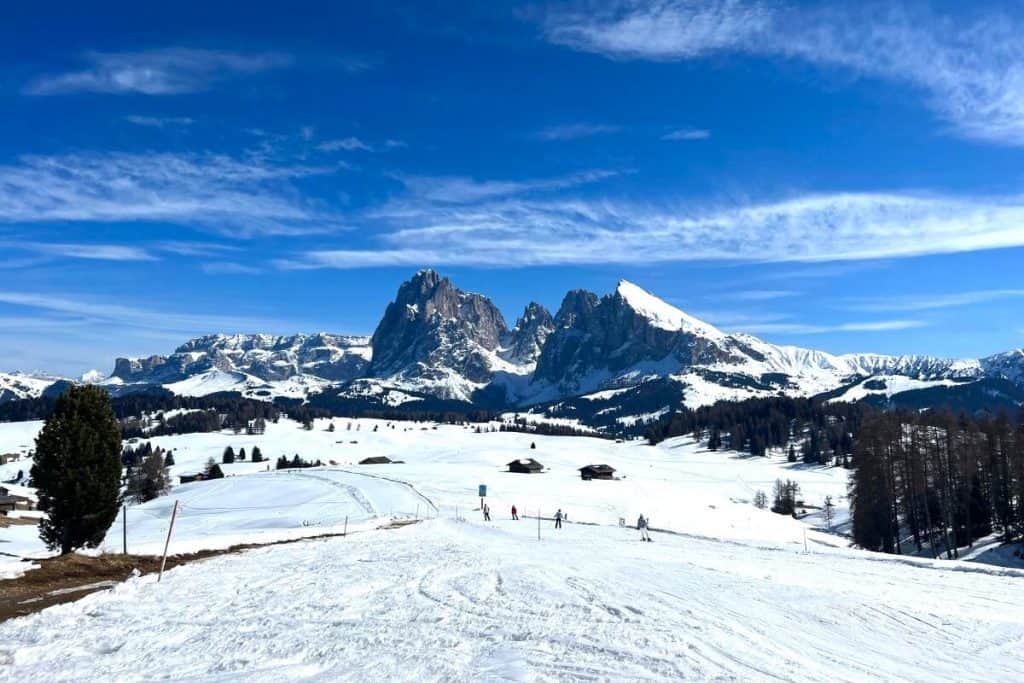
6. Visit The Rifugios
If you’ve read any of my articles about the Dolomites, you know how much I love their rifugios. These are the local mountain huts all around. Some are located on the top of the mountains, some in the forests, some are accessible via cable cars, and for some, you can only walk.
Either way, there is just something magical about stepping inside these cute rifugios, where you can immediately smell fresh apple strudel with some Italian pasta and an Aperol Spritz. Sounds like the best idea, right?
Just take a book, head up there, and enjoy some local specialities while taking in the breathtaking scenery and soaking up the sun.
Here are my favorite and some of the most iconic rifugios in the Dolomites that are also open in the winter:
📍 Rifugio Lagazuoi
📍 Rifugio Scoiattoli
📍 Baita Sofia (Seceda)
📍 Malga Sagnon (Alpe di Siusi)
📍 Sass Pordoi


7. Indulge In A Local Cuisine
Now, we’re in Italy, my friend, don’t forget. And what does it mean for us? Well, eating as much food as we possibly can.
What I found from my travels across the Alps is that the other countries, like Austria and Switzerland, in the mountains, have a very basic cuisine (usually quite overpriced, and you’d be served a sausage with French fries). Not here in Italy, though.
Wherever you go, you’ll love the local dishes. Whether it’s delicious Italian pasta, local specialities like dumplings with cheese and bacon, baked potatoes, or freshly made cakes like apple strudel and tiramisu… indulge in the local cuisine as much as you can.
Here are some of the local South Tyrolean specialities you can try:
👉 Schlutzkrapfen – stuffed pasta with ricotta & spinach
👉 Canederli (Knödel) – bread dumplings with spinach, cheese, bacon
👉 Brettljause (Board Snack) – traditional alpine platter with speck, cheese, grapes, spreads
👉 Krapfen – Southtyrolean doughnuts
👉 Kaiserschmarrn – typical sweet dish, pancake stripes served with cranberry jam


8. Make A Road Trip Through The Mountain Passes
If you have a car, one of the best things to do is just road-trip through the mountain passes. You can either follow the ‘Grande Guerra Loop‘ as I mentioned, or just drive to some of the most iconic passes and enjoy the scenery. Stop at the top for photos and visit museums and local rifugios on the way.
Here are the mountain passes you can drive through in the wintertime:
📍 Passo Falzarego
📍 Passo Pordoi
📍 Passo Fedaia
📍 Passo Gardena
📍 Passo Sella
9. Relax In A Wellness Hotel
The Dolomites have an unforgettable hospitality, Alpine charm, and amazing wellness hotels. So combine your stay with some luxury and relax in an outdoor pool and spa.
There is nothing quite like it when you spend the day in the stunning mountains with crisp air and then get cosy in your hotel, sipping hot chocolate at the wood fireplace, and relaxing in a heated outdoor pool overlooking the peaks.
Here are my favorite wellness hotels in the Dolomites I recommend for you:
🏰 Boutique Hotel Nives – in Selva di Val Gardena
🏰 Passo Sella Dolomiti Mountain Resort – Passo Sella mountain pass
🏰 Cavallino Bianco Family Spa Grand Hotel – great family-friendly hotel in Ortisei
🏰 ICARO Hotel – Alpe di Siusi
🏰 Hotel La Perla – in Corvara (Alta Badia)
🏰 Hotel Tofana Cortina – in Cortina d’Ampezzo
🏰 Dolomiti Lodge Alverà – in Cortina d’Ampezzo
🏰 Lunaris Wellnessresort – in Val Pusteria close to Bruneck
👉 READ ALSO: Where To Stay In The Dolomites: 7 Best Areas & Hotels
Best Places To Visit In The Dolomites In Winter & Map
To help you plan your stay in the Dolomites in winter and see where to go, here are the best places to visit that I recommend:
📍 Alpe Di Siusi
📍 Val Gardena
📍 Cortina d’Ampezzo
📍 Nature Park Fannes-Sennes
📍 Val di Fassa
Alpe di Siusi – for a relaxing holiday away from the crowds, great for couples/romantic holidays, and families who want to gon skiing
Val Gardena – stay in Selva town to enjoy some of the mountain excursions (Seceda, Sass Pordoi), drive around the mountain passes Passo Sella & Passo Gardena, and enjoy local hospitality and nearby towns (Ortisei)
Cortina d’Ampezzo – a major destination for skiing and winter hiking, you can visit Tre Cime di Lavaredo, Rifugio Lagazuoi, follow the Grande Guerra Loop, Cinque Torri, visit local rifugios, and stay in amazing luxury and wellness hotels.
Nature Park Fannes-Sennes – stay in remote rifugios and enjoy the winter wonderland in the Dolomites, like Rifugio Pederu, Rifugio Fannes, or Lavarella, which are less crowded than other areas
Val di Fassa is another location with fewer crowds, with nice wellness hotels, more relaxed, and a slower pace. Visit places like Vigo di Fassa or Pozza di Fassa.
BONUS: Skiing In The Dolomites
I’ve also written a detailed article about all 12 ski regions in the Dolomites, the best ski slopes, my favorites, the best ski-to-door access hotels, and explanations of each area.
Check it out if you want to have an unforgettable ski holiday in the Dolomites. I’ve been skiing here for over 7 years and get to call it my backyard in the winter, so I come here every week for a great ski day. Enjoy:
Practical Tips For Visiting The Dolomites In Winter
I also have some practical tips for you that will help you plan your visit to the Dolomites. Check them out below:
How To Get To The Dolomites In Winter
The easiest way to get to the Dolomites? Think Venice, Milan, Innsbruck, or even Munich – all great starting points depending on your adventure.
From Venice, you can reach Cortina d’Ampezzo in about 2.5 hours, and San Martino di Castrozza is only 2 hours away.
From Milan, it’s around 4 hours to San Martino di Castrozza and Val Gardena is also roughly a 4-hour drive, perfect if you’re planning a multi-stop winter adventure.
Coming from Innsbruck in Austria? You can hit Bruneck/Kronplatz in 2 hours. From there, a little extra drive will take you to Alta Badia in an hour or Cortina d’Ampezzo in about 2 hours.
And if you fly into Munich, plan on about 3.5 hours to reach Bruneck (Kronplatz) or Val Gardena in 4 hours.
How To Get Around The Dolomites In Winter
The best way to get around the Dolomites? Hands down, by car. I always recommend renting one right at the airport – it gives you total freedom, and honestly, the drives themselves are stunning.
The mountain passes stay open in winter and connect all the areas, so you can easily hop from one to another. Picture this: driving winding mountain roads with snowy peaks all around – it’s a whole experience in itself.
That said, getting around by public transport is doable too. There’s a regular bus from Venice to Cortina d’Ampezzo leaving from Mestre’s main train station. From Milan, you can take a train to Bolzano, then hop on a local bus to reach Val Gardena.
From Innsbruck, there’s a direct train to Bruneck, making it easy to visit Kronplatz.
Some buses do run on the mountain passes in winter, but they’re less frequent than in summer. With a bit of planning, though, you can get everywhere even without a car.
PRO TIP: If you’re staying in Val Gardena, you’ll get a guest card that lets you travel for free on all buses and trains – basically anywhere you want to go.
RENT A CAR FOR YOUR ITINERARY

Rent A Car Via Discover Cars – best prices and big selection of car rentals.
PRO TIP: Check ratings of the company you choose before booking (ratings can be off). Go on Google, see ratings of the car rental company, then book on Discover Cars.
Where To Stay In The Dolomites In Winter
I always suggest starting with the area you want to spend most of your holiday in, and then choosing where to stay from there – it just makes planning so much easier.
Generally, the best places to stay are:
👉 Cortina d’Ampezzo: If you’re travelling from Venice
👉 Civetta (Alleghe): If you’re travelling from Venice
👉 Bruneck: If you’re traveling from Austria (Innsbruck) or Germany (Munich)
👉 Val Gardena (Ortisei or Selva): If you’re traveling from Milan
👉 San Martino di Castrozza: if you’re traveling from Milan
👉 Corvara (Alta Badia): if you want to be in the heart of the Dolomites
HEADS UP: Accommodation in the Dolomites sells out really fast – no kidding! To get the best spots, start booking at least 8 months before your holiday. The earlier, the better, seriously.
How Many Days Are Enough For The Dolomites In Winter?
5-7 days are the perfect amount of time to spend in the Dolomites in winter. If you want to do the majority of the activities I listed above, I recommend spending a week.
You can enjoy your hotel and relax in the area for 3 days, then use the remaining 4 days to explore the mountain passes, make mountain excursions, and visit some of the rifugios. Or even go skiing. There is a lot to do to enjoy this winter paradise.
Dolomites In Winter: Weather & Temperatures
The Dolomites in winter? Oh, they’re chilly – and I’ve got some pretty frosty memories from my trips there! I’m not sure if it’s the high peaks or the crisp mountain air, but winter in the Dolomites can really bite, so pack plenty of warm clothes.
Winter temperatures usually range from around 5°C/41°F on mild days to -10°C/14°F when it’s at its coldest. It doesn’t rain a lot, and there is usually a lot of sunshine.
NOVEMBER is often gloomy and foggy. It tends to rain more than the other winter months, with temperatures around 5°C/41°F.
DECEMBER gets cold, with temps dropping to 0°C/32°F or below. The sun shines a lot, so you can soak up the sun here while enjoying the crisp air from the top of the mountains.
JANUARY is usually the coldest month, with temperatures around -5°C/23°F. It’s definitely time for layers, cozy jackets, and hats – snow is almost always guaranteed.
FEBRUARY is similar to January: cold, often snowy, and perfect for those crisp, magical winter days in the mountains.
By MARCH, things start to warm up again, with temperatures climbing back to around 5°C/41°F. The snow usually melts in the lower valleys, and you can already feel spring slowly returning to the mountains.

What To Wear In The Dolomites In Winter
Depending on what you want to do during your stay, bring plenty of layers. If you only want to enjoy easy walks, pack a warm jacket, good winter boots, hats, and gloves, and winter pants + a lot of cozy sweaters.
There are many amazing sports shops and luxury shops in the towns, so you can also come without winter clothes and buy some local things there. Head to La Sportiva, a local sports shop in the Dolomites, or enjoy shopping in some of the local boutiques.
FAQs
I’ve also answered some of the most frequently asked questions. See my answers below:
Does It Snow In The Dolomites In Winter?
Yes, it snows a lot in the Dolomites in winter. The best snowy months are January and February, when the snow is pretty much guaranteed. You’ll love the winter wonderland here.
When Not To Visit The Dolomites?
April and November are not good months to visit the Dolomites. It’s the middle of the season here, and most of the hotels and cable cars are closed, preparing for the next season. So, you can visit, it’s not like everything is closed, but over 80% facilities are not operating.
What To Do In The Dolomites In Winter If You Don’t Ski?
You can do plenty of stuff, from visiting the mountains and rifugios, doing winter hikes, driving through the mountain passes, visiting the museums from WWI, relaxing in a hotel spa, or going cross-country skiing.
Is It Worth Going To The Dolomites In Winter?
Yes, it’s 100% worth visiting the Dolomites in the wintertime. You can do a variety of activities, stay in a wellness hotel, and enjoy the spectacular views.
What Is The Prettiest Town In The Dolomites?
Ortisei is the prettiest town in the Dolomites. It has cute, colorful houses with a tiny church, cobbled streets, and amazing hotels.
WRAP-UP: Dolomites In Winter
This is my full guide for the Dolomites in winter for you. I hope it will help you plan the perfect vacation and decide where to go and what to do. It truly feels like a fairy tale here. So, get the most out of your time, visit as many mountains as you can, relax in a wellness, and enjoy the breathtaking views.
If you have any questions or need help planning your time in the Dolomites, contact me at info(at)voicesoftravel.com. I also create customized travel itineraries, so if you want me to plan your journey within Italy (or anywhere else in Europe), let me know.
Happy Travels!
More Tips For Italy Travel
Looking to visit more places in Italy? Check out my related articles:
Best Of Northern Italy Itinerary: 10 Days With Tips
Where To Stay In The Dolomites: 7 Best Areas & Hotels
Where To Stay In Cortina d’Ampezzo: Best Hotels For Winter/Summer
Skiing In The Dolomites: Full Guide & My Experience
23 Best Places To Visit In Europe In Winter
Is It Worth Visiting Europe In Winter? Answered!
Best Ski Resorts In Europe & My Experience
Italy In Summer: What To Do & Where To Go By An Expert
Milan To Amalfi Coast: Ultimate Guide
9 Best Hotels In Amalfi Town Italy
How To Make A Day Trip From Rome To Amalfi Coast: Full Itinerary
19 Unusual Things To Do In Florence
How Far Is Paris From Italy? Ultimate Guide

About the author: Nicoletta is a travel enthusiast and passionate language learner. While traveling, she loves to connect with locals using her language skills to learn about new cultures. Look for her skiing, hiking in the mountains, or exploring new destinations as she designs travel itineraries for her clients.
ITALY: Interested in more articles for Italy?
Check out my Italy Travel Page:



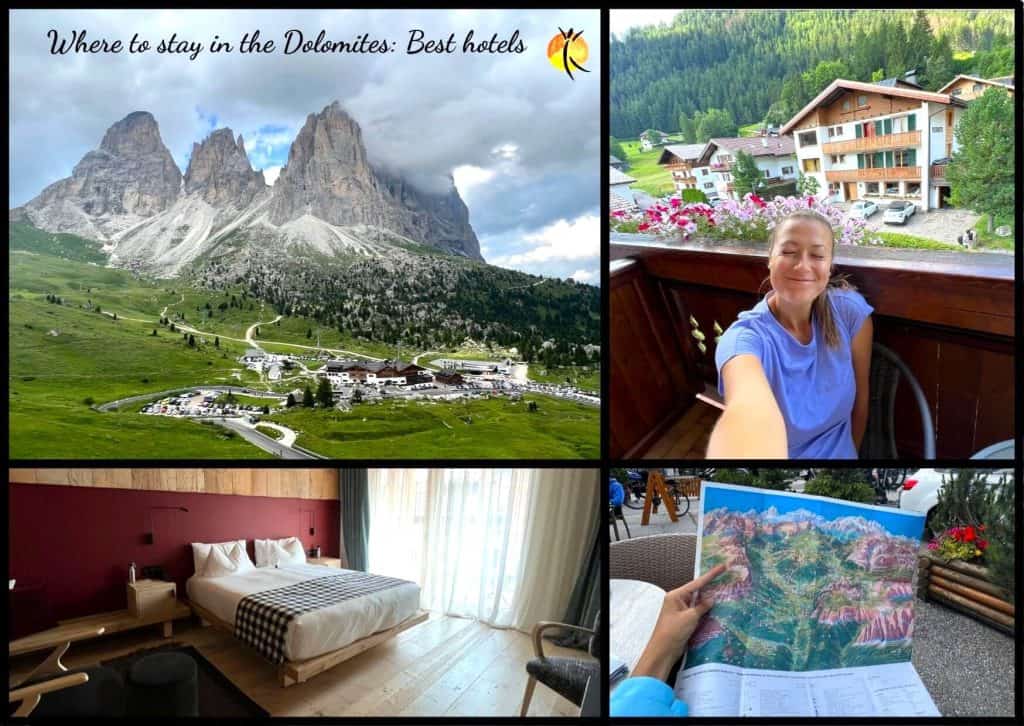
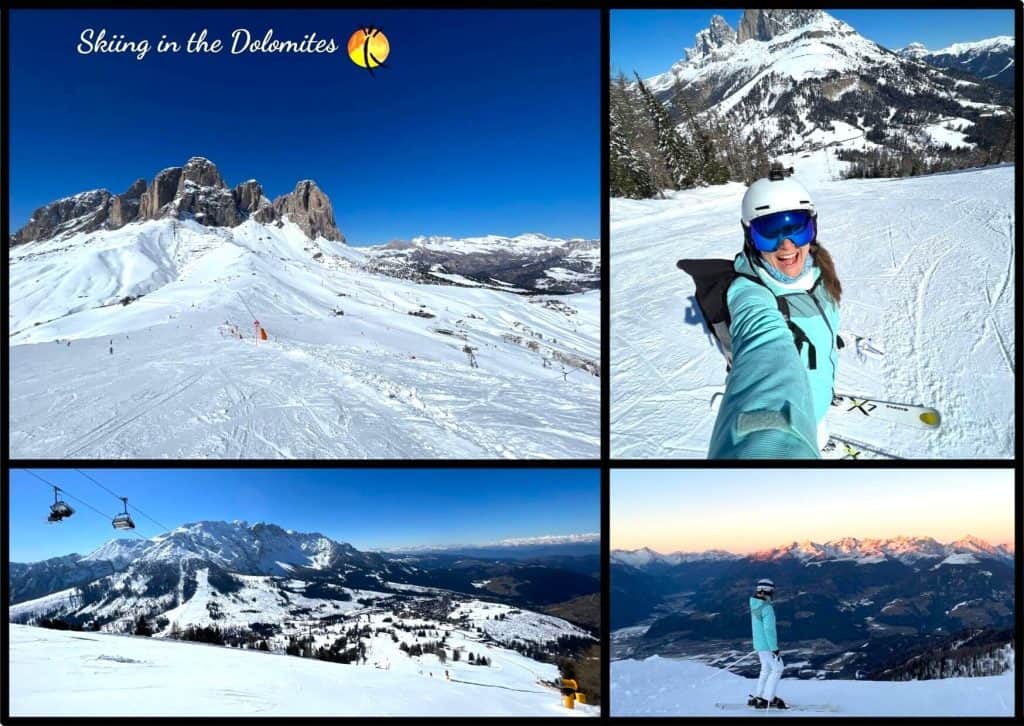

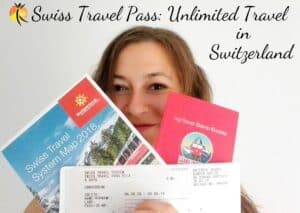

![Read more about the article Istanbul Street Food: 21 Best Turkish Street Foods & Places [2025]](https://voicesoftravel.com/wp-content/uploads/2023/09/Istanbul-street-food-1-300x213.jpg)